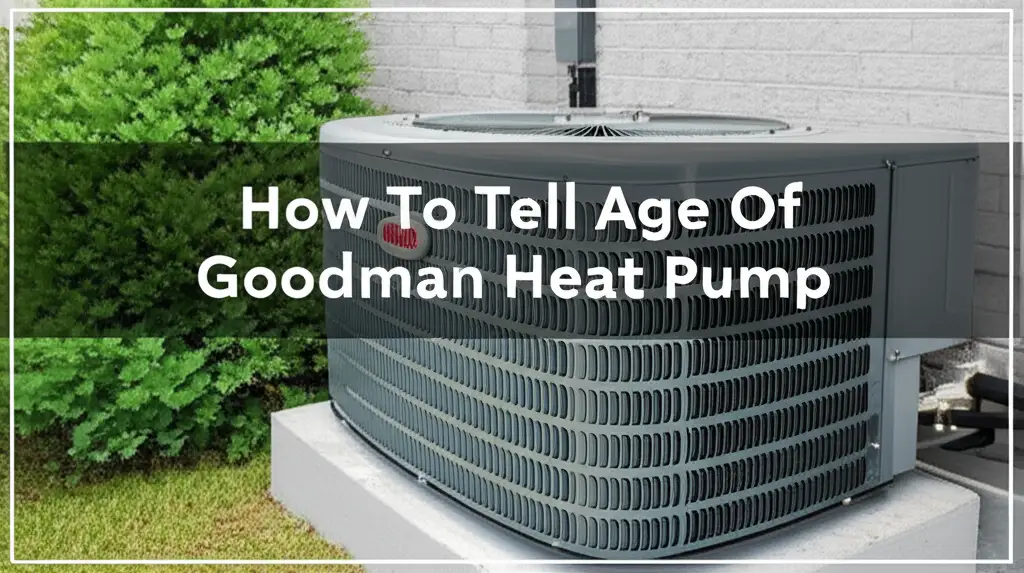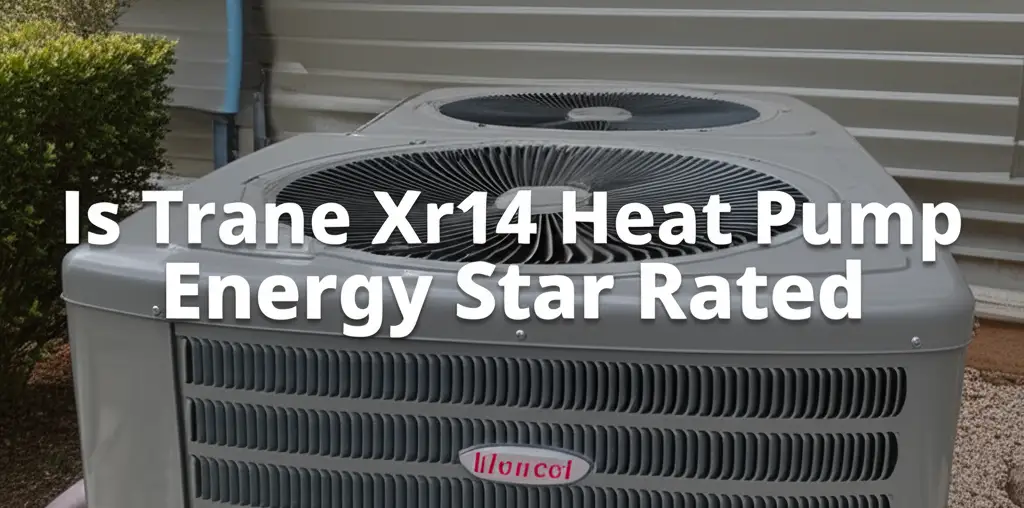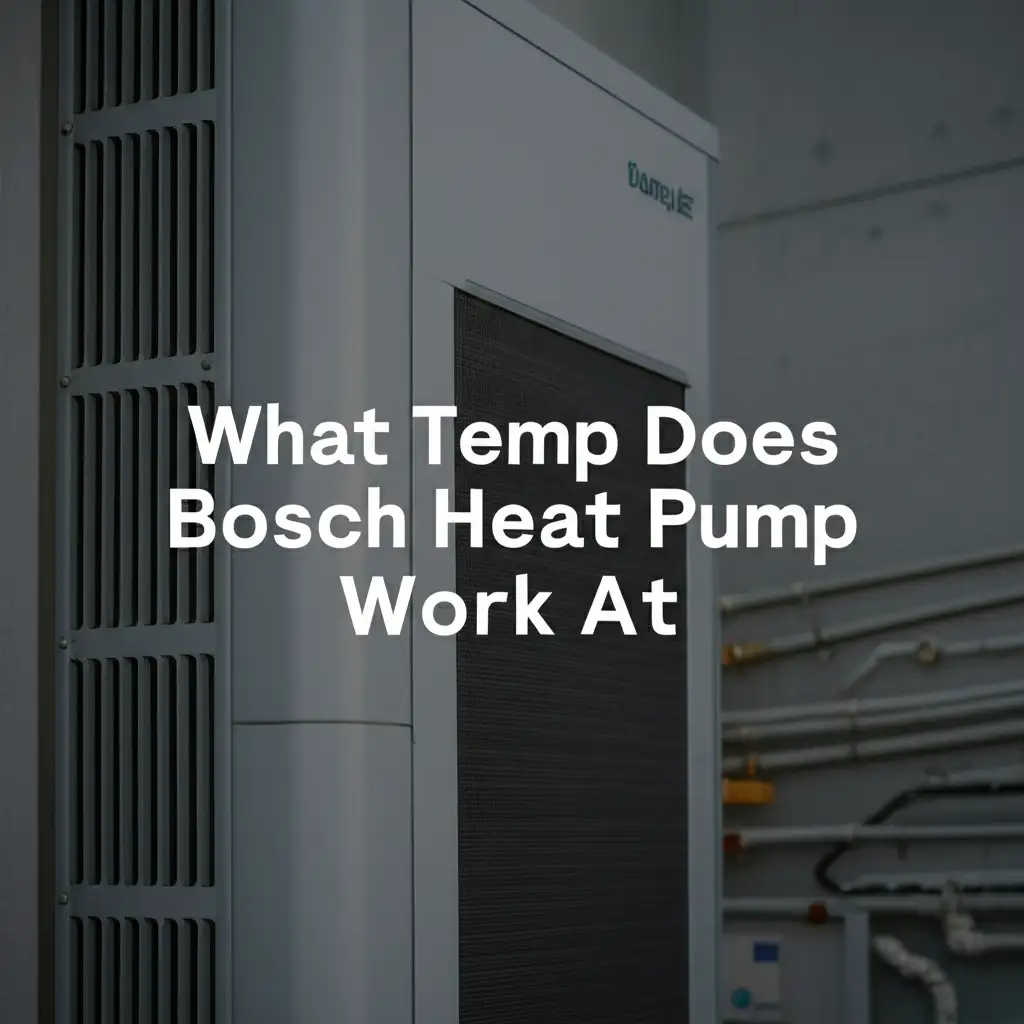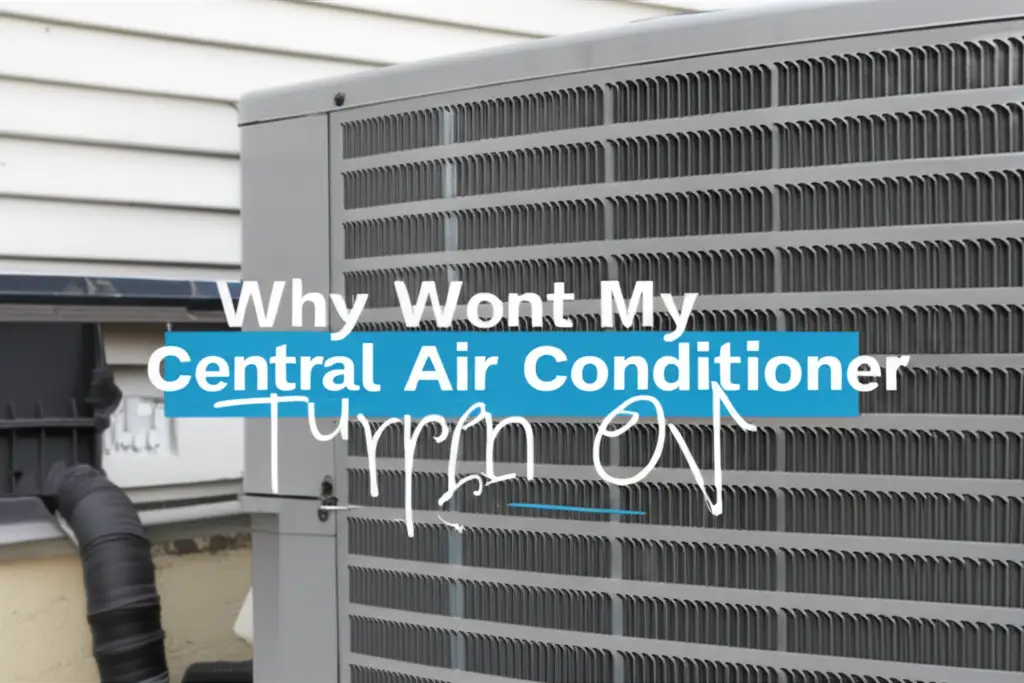· Kianna Connelly · HVAC Systems · 12 min read
How To Tell Age Of Goodman Heat Pump

How To Tell Age Of Your Goodman Heat Pump
Knowing your Goodman heat pump’s age offers many benefits. It helps you understand its remaining lifespan. You can plan for future repairs or replacement. Older units might use more energy. This information is key for maintenance decisions.
This article shows you how to find the age of your Goodman heat pump. We will look at serial numbers. We will discuss model tags. You will learn why knowing the age matters. This guide helps you manage your home’s heating and cooling system better.
Takeaway
Finding your Goodman heat pump’s age is straightforward. Here are the main ways:
- Serial Number: This is the most accurate method. It reveals the manufacturing date.
- Model Number Tag: Provides additional unit details, though not directly the age.
- Visual Inspection: Physical signs can suggest an older unit.
- Professional Help: An HVAC technician can confirm the age and system health.
Your Goodman heat pump’s age is primarily found in its serial number. The serial number includes specific characters that represent the manufacturing year and month. Locate the data tag on the outdoor unit or indoor air handler. The fourth and fifth characters of the serial number often indicate the year of manufacture. The second and third characters typically represent the month.
Understanding Goodman Serial Numbers
Locating the serial number is the best way to tell the age of your Goodman heat pump. Every Goodman unit has a unique serial number. This number is like a birth certificate. It contains the exact manufacturing date. You will find this number on a data tag. This tag is usually on the outdoor condenser unit. It can also be on the indoor air handler or furnace.
Goodman, like many HVAC brands, uses a standard format for its serial numbers. Once you find the tag, look for the serial number. It will be a string of letters and numbers. The key to decoding the age lies within specific positions of this string. This system makes it easy to pinpoint the date.
Locating the Serial Number Tag
Finding the data tag is the first step. For outdoor units, look on the side or back. It is often near the refrigerant lines. The tag is usually a metallic sticker. For indoor units, check the cabinet. It might be on the front panel or inside a service door. Take a clear photo of the tag. This helps avoid errors when writing down the number.
Make sure the area is clean. Dust or grime can hide the details. Sometimes, the tag fades over time. If you cannot read it, try shining a flashlight. This can make the numbers more visible. Accessing the tag might require opening a panel. Always turn off power to the unit before doing this. Safety is always important.
Decoding the Manufacturing Date
Goodman serial numbers follow a specific pattern. The second and third characters typically indicate the manufacturing month. The fourth and fifth characters show the manufacturing year. For example, if the serial number is “XX0815XXXXX”, “08” could mean August. “15” would mean the year 2015. This pattern applies to most Goodman units.
However, sometimes the pattern differs. Older units might use a slightly different code. It is good to cross-reference with official Goodman resources. You can also contact Goodman support with the full serial number. They can provide the precise manufacturing date. This method provides the most accurate age information.
Goodman heat pump serial numbers are designed to give you precise manufacturing details. For many current models, the first two numbers after the initial two letters often represent the year. The next two numbers represent the month. For instance, if you see “1805” as part of the serial, it means May 2018. This system is generally consistent across Goodman units, making decoding simple.
Goodman Model Numbers and What They Tell You
While a Goodman model number does not directly tell you the unit’s age, it provides valuable information. The model number identifies the unit’s specific series and features. It can tell you the tonnage (size), efficiency rating (SEER/HSPF), and whether it is a single-stage, two-stage, or variable-speed unit. Knowing these details helps understand the unit’s capabilities. It also helps assess its energy efficiency.
Often, model numbers include letters and numbers that describe the unit’s generation or specific enhancements. Newer generations of models usually have higher efficiency ratings. They might also include different refrigerants. You can use the model number to look up specifications online. This helps determine if your unit is an older or newer design. You can also learn how to tell what size heat pump you have by understanding these numbers.
For example, a model number might include “GSZ” for a specific heat pump series. The numbers after that indicate tonnage and efficiency. While it does not give the exact age, it can place the unit within a certain period. This is useful for finding compatible parts if repairs are needed. It helps you understand if you have an older or newer design.
Why Knowing Your Heat Pump’s Age Matters
Knowing the age of your Goodman heat pump is more important than you might think. It helps you predict its performance. It also helps plan for future expenses. Heat pumps, like any appliance, have a finite lifespan. Typically, a well-maintained heat pump lasts 10 to 15 years. Some units can last longer with good care. Understanding its age allows you to make informed decisions.
First, age affects efficiency. Older units often have lower SEER ratings. This means they use more electricity to produce the same amount of heating or cooling. Knowing the age helps you calculate potential energy savings from an upgrade. Second, age impacts reliability. Older units are more prone to breakdowns. Parts can become harder to find. This means more frequent repair calls.
Third, age is crucial for warranty claims. Most Goodman warranties cover parts for 5 or 10 years. If your unit is older than the warranty period, you will pay for parts yourself. Fourth, it helps in home selling. A newer HVAC system is a big selling point. Knowing its age adds value to your property listing. It also helps you set realistic expectations for buyers.
Factors Affecting Heat Pump Lifespan Beyond Age
While age is a significant factor, many other elements influence a Goodman heat pump’s lifespan. These factors can extend or shorten how long your unit lasts. Understanding them helps you take steps to maximize your system’s life. It means you get the most value from your investment.
One key factor is regular maintenance. A well-maintained heat pump lasts longer. This includes routine cleaning, filter changes, and professional tune-ups. Neglecting maintenance leads to wear and tear. This shortens the unit’s life. Think of it like a car; regular oil changes keep it running smoothly. You should also regularly learn how to clean heat pump coils for optimal performance.
Installation quality also plays a role. A properly sized and installed unit performs better. It experiences less stress. Incorrect installation can cause parts to fail prematurely. Always choose a certified HVAC technician for installation. They ensure the unit fits your home’s needs.
Usage patterns matter too. A heat pump running constantly in extreme climates will wear out faster. Units in mild climates might last longer. The workload affects the compressor and other components. Managing your thermostat wisely can reduce strain.
Finally, climate conditions impact longevity. Units in coastal areas face salt corrosion. Units in dusty regions might have more filter clogs. Protecting the outdoor unit from harsh elements helps. Consider a cover in winter if advised by your technician. These elements combine to determine how long your specific unit will provide comfort.
Visual Inspection for Age Clues
Sometimes, you cannot find the serial number. Or the tag is unreadable. In such cases, a visual inspection can offer clues about your Goodman heat pump’s age. While not precise, it helps estimate if the unit is old or relatively new. You can spot general signs of wear and tear.
Look for obvious physical damage. Rust on the outdoor unit’s cabinet indicates age and exposure. Dents or faded paint suggest years of use. Older units might look bulkier. Newer models often have sleeker designs. They also might have different external features.
Check the refrigerant type. Older heat pumps might use R-22 refrigerant. This is an older, phased-out type. If your unit uses R-22, it is likely at least 10-15 years old. Newer units use R-410A. This is a sign of a more modern system. The refrigerant type is usually listed on the data tag.
Also, look at the technology. Does the unit have advanced features? Variable-speed compressors or smart controls are newer innovations. Basic, single-speed units are often older. The presence of simpler components can hint at an older design.
Finally, check for repair history indicators. Are there many patched-up areas? Are different parts painted differently? This suggests multiple repairs over time. Many repairs often mean an older system. These visual cues, when combined, provide a general idea of the heat pump’s age.
When to Consider Heat Pump Replacement
Knowing your Goodman heat pump’s age helps you decide when to replace it. A typical heat pump lasts 10-15 years. If your unit approaches this age, consider replacement. Especially if it shows signs of decline. Replacement can save you money and headaches in the long run.
Frequent breakdowns are a major sign. If you are calling for repairs multiple times a year, replacement is often more cost-effective. Repair costs can quickly add up. Sometimes, a single major repair can cost almost as much as a new unit. Evaluate if it’s worth investing in an aging system.
Reduced efficiency is another indicator. Older units are less efficient. They consume more energy to heat or cool your home. This leads to higher utility bills. A new, high-efficiency heat pump can significantly lower your energy costs. The savings can offset the cost of the new unit.
Noise levels can also increase with age. An older heat pump might make loud noises. These noises can indicate failing parts. If your unit becomes excessively loud, it might be time for an upgrade. New units are generally much quieter.
Consider replacement if your unit uses R-22 refrigerant. R-22 is becoming scarce and expensive. If a repair requires adding refrigerant, the cost will be very high. Switching to a new unit with R-410A avoids this issue. Ultimately, if your aged heat pump struggles to keep your home comfortable, it’s time for a replacement.
Professional Assistance for HVAC System Assessment
Sometimes, figuring out your Goodman heat pump’s age or condition can be hard. The serial number might be unreadable. You might not understand the codes. In these situations, calling a professional HVAC technician is the best choice. They have the tools and expertise.
A certified technician can quickly locate and decode the serial number. They understand the nuances of different manufacturing codes. They can tell you the exact age of your unit. This removes any guesswork. They also check the overall health of your heat pump.
Professionals perform a comprehensive system assessment. They check refrigerant levels. They inspect electrical components. They test the compressor and fan motors. This assessment goes beyond just age. It gives you a full picture of your unit’s performance. They can tell you if your heat pump is working correctly.
They can also advise on necessary repairs. Or they can suggest if replacement is a better option. They provide cost estimates for both. This helps you make an informed decision. Investing in a professional assessment ensures your HVAC system runs efficiently and safely. It provides peace of mind.
FAQ Section
How long do Goodman heat pumps last?
Goodman heat pumps typically last 10 to 15 years. This lifespan depends on factors like regular maintenance and proper installation. Units in mild climates may last longer. Extreme use or neglected service can shorten their life. Regular tune-ups help maximize their operational years.
Can I find the age without the serial number?
Finding the exact age without the serial number is hard. Visual clues like rust or older refrigerant types can suggest age. But these are estimations. Model numbers provide general unit details, not the precise manufacturing date. A professional HVAC technician can often help if the tag is unreadable.
Does the model number show the age?
No, the model number does not directly show the age of your Goodman heat pump. It tells you about the unit’s features, series, and capacity. The serial number contains the manufacturing date. Always refer to the serial number for the precise age.
Why is my old Goodman heat pump inefficient?
Older Goodman heat pumps are less efficient for several reasons. Technology improves over time; new units have higher SEER ratings. Components wear out in older units, reducing performance. They might also use R-22 refrigerant, which is less efficient than newer R-410A systems.
Is an older heat pump worth repairing?
Deciding to repair an older heat pump depends on the cost. If repair costs exceed 50% of a new unit’s price, replacement is often better. Consider if the unit is nearing the end of its typical lifespan. Frequent breakdowns also indicate that replacement might be a smarter investment.
Conclusion
Knowing the age of your Goodman heat pump is valuable information for any homeowner. It helps you anticipate its remaining useful life. You can make informed decisions about maintenance, repairs, or eventual replacement. The most accurate way to find this is by decoding the serial number on the unit’s data tag. Look for the month and year embedded within those characters.
Beyond the serial number, visual cues and model number details can provide context about your unit. Remember that regular maintenance extends its lifespan. When your Goodman heat pump approaches or exceeds 10-15 years, consider professional assessment. This helps ensure your home stays comfortable and energy-efficient. Take control of your HVAC system’s future today.





